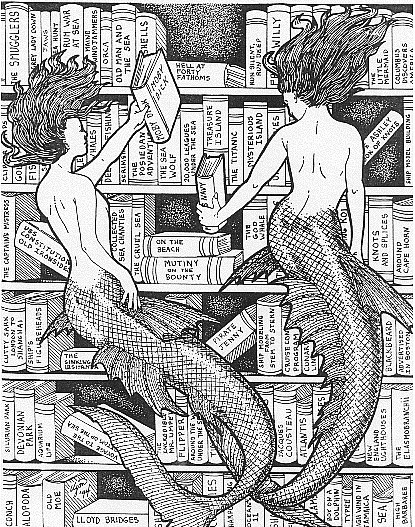
It Goes On The Shelf
Published at The Sign of the Purple Mouth by Ned Brooks
Cover art by Linda Michaels
Web Hosting Domain | Free Website | WebSite Hosting | |

Interior art by Julia McCune Flory from Round-About to Canterbury
I must apologize for the math booboo lastish, which several readers caught -
I must also apologize for having told several other Hannes Bok fans that I thought Emil Petaja was dead - here he is in the Nebula Award Banquet photos in the June'95 issue of Locus looking great!
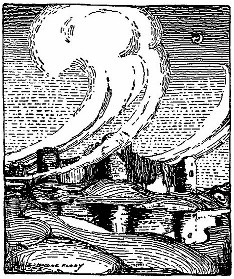
Phone Cards - Anybody know where I can get phone cards? I don't mean phone credit cards, but cards that are sold with some amount of phone-use value in them and then discarded when it's used up. Alan Hunter, the British fan doing the Green Hills of Earth art, wants them for his son. If you know any US collectors, he sent some British samples I could trade. Lost Fan Alert - I would like to get addresses for Cindy Heap, Elliott Shorter, and Chuck (Jason) Rein so I can send them copies of the Green Hills of Earth booklet in preparation.
The Fires of Heaven by Robert Jordan, Tor, New York, 1993, wraps, $6.99.
This is the fifth (but not last) of Robert Jordan's Wheel of Time
series. You get your money's worth with Jordan - this trade pb is just under
1000 pages, over 2 inches thick! There is a 25pp glossary and a full-color map,
as well. I am sending these to Mae Strelkov - I have not gotten through the
first volume myself.
Letters From Home by Gene Wolfe, United Mythologies Press (Box 390,
Sta.A), Weston (Ontario Canada), 1991, 185pp, illus photos, wraps.
This is a collection of letters that Wolfe wrote from Korea in the early 1950s - he sent
me this signed copy with a loc on IGOTS 13! I will have to take his word for it
that the young fellow in some of the photos is him, there isn't much resemblance
in the binding to the current edition...
Mr Wolfe says he particularly likes Dave Hall's map of Hodgson's `Night Land'; and explains a bit more about the `poisonous' tomatoes: "Tomatoes were once called `love apples' and thought to be aphrodisiacs; for this reason, children were taught that they were poisonous. My grandmother, who I suppose must have been born around 1870, was told this. She explained to me (I would have been eight or nine) that `it was because the big people wanted them.'"
Vultures of the Void by Philip Harbottle and Stephen Holland, Borgo Press
(Box 2845), San Bernadino (CA 92406), 128pp, illus Ron Turner, index, wraps.
The price does not appear. This was offered in the Zardoz catalog from
England, where they also offered to buy vintage sf paperbacks. I offered them
some in trade for it, but they never answered. I'm glad I got this history of
British sf publishing 1946-1956, it notes that Hannes Bok artwork from a 1941
Future Fiction that originally illustrated Martin Pearson's Pogo
Planet was used in a 1954 British magazine called Space Fact and
Fiction to illustrate Ray Cummings' The Man On The Meteor, and this
idiocy then rebound and sold as a book called Space Fact and Fiction
Album - I can add this data to my Bok index.
Walt Willis writes "I was interested to see you're starting on The Night Land, because it used to be one of my favourite books. In fact I remember thinking with regret that I'd probably only be able to read it one more time before I die. I also remember the astonishment with which I realised that my rules of thumb in deciding whether to take out a book on spec from the library included no dialects, no history and no first person narratives. The shock came from realising that all of my life-time favourites were first person narratives, namely The Coral Island, Jane Eyre and The Night Land.
It's difficult for me to recall exactly why I enjoyed The Night Land so much. Now I remember only incidentals, such as the fact that the narrative was continuous - I mean there was no jumping from one episode to another. It was as if the story were the work of an unsophisticated writer, determined to recount everything that happened. Another thing I remember is the quite plausible explanation of dehydrated water. I also remember a distasteful episode of male chauvinism, which I wrote off as a peculiarity of the times.
Among the rest of the contents, I was very interested to learn of the existence of Years of Light. I remember Light well. I was quite astonished to learn that the Empire State Building weighs less than the dirt and rock excavated for its foundation. I would have found it easier to believe it weighed exactly the same, on the analogy of a tree, whose roots are said to stretch as far as its branches."
{It could be argued that The Night Land is in dialect as well - at least that bad imitation of William Morris isn't standard English! Now that Dave Hall's 10:1 condensation is published I'll send you one. Who wrote The Coral Island? I never heard of that. I can only assume that the factoid about the Empire State Building is correct, I don't have the data on hand to check it - the building probably got a lot heavier after the lawyers moved in.}
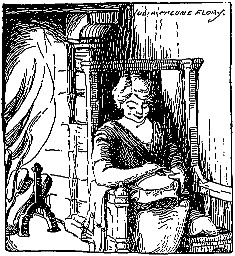
Round-About to Canterbury by Charles S. Brooks, Harcourt Brace, New
York, 1926, 346pp, illustrated by Julia McCune Flory, $3.00.
This is the last of the three books by Charles S. Brooks with Flory art that I have in
my collection (and the only one with a d/w) - there are at least three others (A
Thread of English Road, Roads to the North and Like Summer's Cloud)
that I would like to have.
As you might imagine, this is a travel book. The end-paper maps (also by Flory) show the route taken in a walking tour from London to Canterbury in a great loop through Rye, Chichester, and Guildford by the author and two friends - about 300 miles in about a month. There is no explanation as to whether Ms Flory worked from photographs or from the author's descriptions. Her pictures - each of the 25 chapters has one or two - match the text very closely. I will snitch some of them to decorate this zine.
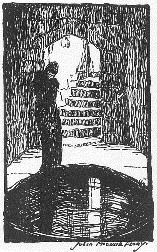
Dave Hall's condensation of Hodgson's The Night Land has been scanned into memory and published with Dave's maps at $10. In the meantime I have recieved another remarkable book of eldritch sf:
The Perfect World by Ella Scrymsour, Nash & Grayson, London, nd,
320pp.
also - Frederick A. Stokes, NY, 1922, 316pp, reset.
Vince Clarke sent me this moldering tome, which Reginald and Locke both date to 1922.
Reginald also lists another by the same author, The Bridge of Distances
(1924).
I mention this book in connection with The Night Land because they are similar in several ways - both are from the same period, both are utterly humorless, and both make use of the idea of dehydrated water (Hodgson's is a powder that turns to water when the air hits it, while Ms Scrymsour's is a 1-inch cube of what looks like camphor that makes a quart of water when heated).
The lack of humor makes these books hard to plow through, though The Perfect World is written in conventional English prose and reads far more easily than the obsessively-detailed pseudo-archaic firstperson narrative of The Night Land. In a way this makes the technical howlers in Ms Scrymsour's book more startling - her prose is conventional, her very British characters are conventional, and yet, in spite of her bizarre imagination, she apparently had a very dim grasp of physical reality.
The story starts off as a supernatural thriller - our heroes come to a small village to learn the coal-mining business, as their uncle and guardian (who in his spare time is buiding an airship powered by a mixture of `petrol, radium, and theolin') owns the mine. They apparently set off a local curse (dating from Henry VIII's seizure of the monasteries) that forbids strangers in the village, but the link of this curse to subsequent events is never explained and is soon forgotten when one of them vanishes and the other is lost in a mine cave-in. As soon as the action moves underground, Ms Scrymsour's deficiencies in physics become noticeable - the hero lost in the cave-in finds himself by an underground stream and throws in a piece of coal to see how deep it is! "There was a slight splash, but no sound came to tell him that it had reached the bottom". He eventually comes upon humanoid creatures - "no more than three foot six inches", with purple skin, flaxen hair, and a ten-inch horn in the middle of the forehead. One of these attacks him - "he beat his horn in Alan's face". I find this impossible to visualize.
The horned purple midgets (the High Priestess has "small and pretty" features, "almost of English mould") turn out to be the descendants of ancient Hebrews swallowed up by the earth for defying Moses (see Numbers 16, v.31); and our heroes (the one who vanished is found by the one lost from the mine - he had been dragged down into the bowels of the earth by an incomprehensible sort of electric rope that the troglodytes have for that purpose), who have had proper classical educations at Queens College, Cambridge, soon learn to speak their corrupted Hebrew. Moses is dated to 1400 BC here, so the people of the underworld have had 3300 years to turn purple and grow horns.
After further underground adventures our heroes escape to the surface with one of the midgets, who turns to dust as soon as the sunlight strikes her. They find that five years have passed, they have missed WWI, and they are in Australia.
As with the Curse, the plot now abandons the purple midgets. One of our heroes takes his Australian nurse home as his wife, and they find that the uncle, in his grief at their disappearance, has become a hermit and perfected his 900-foot aluminium aircraft, the Argenta. They take it up for a spin and then the world is destroyed.
Fortunately, the Argenta is fitted with an optional outer hull that "unfolds and clips into position by means of strong clasps" at the pull of a lever. The space between the hulls is then filled with a "mixture of gases of which ether is the chief component". The ship with our heroes, wife, baby, uncle, and an engineer and a mechanic is hurled into outer space. After a year or so they reach Jupiter, almost dead of hunger and thirst. The mechanic goes out too soon and dies of the sulfurous gases of the upper atmosphere.
Oddly enough, the basic data on Jupiter is about right - it is five times as far from the Sun as the Earth and our heroes realize that this would give it only 1/25 the solar radiation. The pleasant climate is explained by a crude version of the greenhouse effect. The surface gravity of Jupiter is given as three times Earth normal, and that checks with my reference book as well.
Jupiter has a planet-wide advanced civilization of humans descended from an Adam and Eve who did not sin and so were never cast out of their garden. Sin, however, is not absent. After a battle with a devil-worshipper for the hand of the princess, our unmarried hero marries her and eventually becomes King of Jupiter and lives happily ever after.
It would make a great movie...
Weird New Jersey edited by Mark Sceurman (Box 1346, Bloomfield NJ 07003) is a $5 once-a-year magazine recommended by Tony Pizzini in Richmond, who also sends some stamps, and claims to be 36 with a wife named Jackie and a "pitiful little son" named Ferret Cecil. The magazine has articles on the Manunka Chunk Tunnels as well as the Ogdenburg "backwards tunnel" - do you have to back through it, or what?
AE: The Seven Wonders of the Universe by Mike Johnson, Hilltop Press,
1994, art by Harry Turner, 12pp, wraps, $2.50.
Steve Sneyd send this book of verse - not my sort of thing, alas, but the art is nice!
The Secret of the Sangraal by Arthur Machen from Tartarus Press was ruined at the binders and is being redone and so will be delayed, according to publisher Ray Russell. Ray also asks what the `Slan' in Slanapa (an amateur press association or `apa' that had its 300th monthly mailing and thus its 25th anniversary in January) stands for - this is a matter of debate in the apa (which I have been in since the beginning). Some say it is from the Van Vogt novel Slan and the old catchphrase `fans are slans', while others insist that it stands for slanderous.
The War of the Flowers by Jon DeCles, Darroll & Rosemary Pardoe
(Flat One, 36 Hamilton Street, Hoole Chester CH2 3JQ, England), 16pp, wraps, $1
(cash or 2 IRCs).
I knew Don Studebaker (who later became Jon DeCles and founded the Society for Creative
Anachronism) in Philadelphia in the 1960s. This is his account of the People's Park
affair, originally published in the apa OMPA. Highly recommended!
Century (Box 9270, Madison WI 53715-0270) sends their 16pp `special preview issue', hinting that I should subscribe ($27/6 issues a year). The editor is a Robert Killheffer, and he says they intend to publish literary material in the genre. The four fragments given as samples are not bad, though I never heard of any of the authors. The only art is an atrocious collage cover.
The Best of Whispers edited by Stuart David Schiff, Borderlands
Press / Whispers Press, Baltimore/Binghamton, 1994, 470pp, color d/w and b&w
frontis by Lee Brown Coye, 500 numbered signed copies, boxed, $65.
I had not heard from Schiff in some time, and was surprised to learn that I had a credit
as a subscriber to Whispers. This is a beautiful anthology, signed by 17
of the authors and Schiff himself - Ray Bradbury, Hugh B. Cave, the late Karl
Edward Wagner, William F. Nolan, Ramsey Campbell - even our own Steve Sneyd.
Schiff mentions that a trade pb is under consideration. Two addresses are given
for the two imprints - Borderlands at Box 146, Brooklandville MD 21022; and
Schiff's home address, 70 Highland Avenue, Binghamton NY 13905.
Stuart notes that quite a few of the back issues are still available from him at $3-9 each.
Miss Margaret Cheeseman at The Corner Shop (116 East Water, Portland IN 47371) sends a detailed list of the collection of 28 Donn Byrne books that Ray Zorn had on consignment with her. If anyone is interested I will be glad to provide a copy of the 3 pages. I have accumulated several Byrne books over the years, and have read at least two of them, Blind Raftery and Crusade - I remember I was glancing at the illos in Blind Raftery and was caught by a few lines of text in the middle - "`O Bartholomew Joyce,' said Raftery quietly, `have I honored your house, only to be insulted by this lewd Anabaptist?'" read it to the end and back to where I started on the spot. Of course it is a relatively small book... These books are now here, and I see that they include two editions of the bibliography and some duplicates - contact me if you are interested.
Lord Dunsany / A Bibliography by S. T. Joshi and Darrell Schweitzer,
The Scarecrow Press, Metuchen NJ and London, 1993, 363pp, indices, no d/w,
$42.50.
The price is from memory, but this is the 90th bibliography from this firm, so I expect
you will find them in BIP if you are interested - the book itself gives no address. This
is a very detailed work (long overdue in my opinion for a writer of Dunsany's stature),
and yet there are details still unsettled - I glanced in the Index of Names and found
that Dunsany had apparently once done an introduction for an edition of Arthur Machen's
The Hill of Dreams published by Richards in 1954, Corgi in 1967, and Baker in
1968. The compilers were only able to find the last of these three editions.
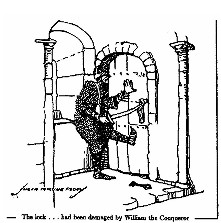
Dawn and the Dons by Tirey L. Ford, A M Robertson, San Francisco,
1926, 236pp, index, illus in line by Jo Mora.
A book in very good condition though with no d/w that I don't remember buying but found
carefully put away in a plastic bag. It is a history of Monterey California. The art is
excellent, and there is a lot of it, almost every other page has something.
What Time Has Use For by Steve Sneyd, K.T.Publications, Stamford
(Lincolnshire, UK), 1994 (reprinted from 1992), 16pp., wraps.
A collection of his verse about King Arthur, very much in the modern style of poetry - it
do not mean but be.
Frogassic Pork edited by Janet Fox, Scavenger (519 Ellinwood), Osage
City (KS), 1994, 34pp, art by divers hands, wraps, $3.50.
These are the winners of the 1994 Killer Frog Contest for humorous or overdone horror.
They certainly are... I like Mark Rich's poem Deranger in Deranged Land, also
Erik Buck's The Witch.
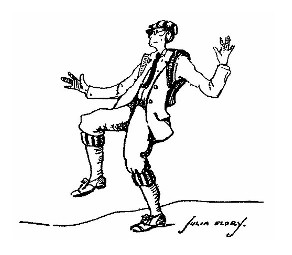
Keep Off The Grass by George Allan England, Small,Maynard&Co.,
Boston, 1919, 140pp, illus by the author.
Another dusty tome I found while looking for something else - at least it was shelved
with what little I have of his other books, the Avalon reprint of Darkness and
Dawn and a mystery, The Alibi. This particular book is a rare achievement for
its time - not one word of it makes the least bit of sense - as common as such books
have become of late.
Peake Studies, edited by G Peter Winnington (Les 3 Chasseurs, 1413 Orzens, Vaud, Switzerland) is a magazine dedicated to the works of Mervyn Peake. Dainis Bisenieks found four issues (out of, apparently, 13 that have been published) on the street in Philadelphia, and sent them to me.
The latest issue is dated Winter 1994, so this is apparently an active publication. The editor asks that you send $25 (or 15 pounds sterling) from which he will deduct a cost per page - an odd but sensible arrangement.
I was glad to see here an explanation of the rumors I had heard of an opera based on Gormenghast. It seems there were two sources for this rumor - one was that Peake had hoped that Benjamin Britten would do one and actually put Britten's name on a manuscript even though there is no evidence that Britten had consented to the project; another is that there was, in the spring of 1992 at the Battersea Arts Theatre in London, a theatrical production by the David Glass Ensemble based on Titus Groan and Gormenghast. Reviews were mixed, but it seems that at least some of those already familiar with the novels enjoyed the production very much.
These digest-size magazines are well-produced and contain occasional bits of Peake art, some of it previously unpublished. I have gotten the remaining issues.
The Ultimate Guide to Science Fiction by David Pringle, Scolar Press
(Old Post Road), Brookfield (VT 05036), 1995, 501pp, $59.50.
But it's a 2nd edition, so I guess the first one wasn't all that ultimate... This lists
3500 novels, collections, and anthologies published through the end of 1993 according
to the flyer - nowhere near ultimate, I fear! I have more than that in my puny
collection!
Report to St. Peter by Hendrik Willem van Loon, Simon & Schuster,
New York, 1947, 220pp, illustrated by the author in color and b&w.
The dealer told me that this memoir was Van Loon's last book. He had a pleasant
style in both prose and art, and illustrated most of his own books. In a
meditation on his ancestry, he works out that we each have 48x1015
ancestors counting back to the time of Christ - but not really, because most of
them were `absorbed by their cousiniquity'. That is, the further back you
go the more often you find that you are descended from the same person several
different ways, through the intermarriage of 2nd, 3rd, 4th, etc cousins.
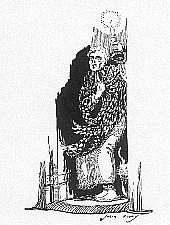
Hydriotaphia by Thomas Browne, Henry Broome (at the Signe of the Gun
in Ivy-Lane), London, 1658, 202pp.
This includes both Urne-Buriall and The Garden of Cyrus - not the original
edition, but a facsimile published in New York in 1927 by Payson & Clarke.
It is very curious to try to decipher such material from over 300 years ago. Urne-Buriall has to do with `sepulchrall urnes lately found in Norfolk', that is, burial sites that were already ancient in 1658. Apparently some of Browne's distant ancestors were buried in urns, and this is an account of the discovery. There is a plate showing four urns, and a great deal of speculation as to when they were buried. All apparently contained only the bones of bodies that had been burned, and Browne notes that those found in Anglesea were buried with the mouth of the urn downwards.
The Garden of Cyrus is subtitled `The Quincunciall, Lozenge, or Net-work Plantations of the Ancients, Artificially, Naturally, Mystically considered'. It seems to be a demented mixture of the history of formal gardens and the numerology of plants. Brown claims, for example, that the oak is `quincunciall', that is, five-sided: "And after this manner doth lay the foundation of the circular branches of the Oak, which being five-cornered, in the tender annual sprouts, and manifesting upon incision the signature of a Starre, is after made circular, and swel'd into a round body: Which practice of nature is become a point of art, and makes two problemes in Euclide."
Wieland by Charles Brockden Brown, edited by Fred Lewis Pattee, Harcourt Brace,
New York, 1926, 351pp.
I tried long ago to read this 1798 novel, and gave it up as inpenetrably turgid. This
volume also contains the fragment that had been written when the author died at 39 in
1810 of Carwin the Biloquist. This is quite clearly a fantasy - the protagonist
learns ventriloquism by studying echoes. This sort of thing must have been the origin
of the belief that it is actually possible to `throw' the voice.
Unique Tales by M. Y. T. H. Myth, The Abbey Press, New York (also London
and Montreal), 1901, 158pp.
Some years ago Tom Cockcroft asked me to get him a copy of Hallie Marshall, A True
Daughter of the South by Frank P. Williams as being a very early example of
alternate history. This book was also from the Abbey Press (1900), and the best I
could do was a xerox of an inter-library loan copy. At Atlanta Vintage Books I found a
stack of books from this press, and bought just the Unique Tales for comparison.
Sure enough, it is the same press, as the typography of the title page is identical.
The Abbey Press seems to have been a curious sort of multi-national corporation for
its time - there are 6 pages of ads in the back of Unique Tales, and yet
of the over 300 titles, not one is by an author I ever heard of except for the
Frank Williams book. Perhaps it was a vanity press - one of the titles offered
is The Diabolical in Scripture and in Human Life by Harold Stormbrow!
About the three Unique Tales, the less said the better... There is a character named Thusnelda!
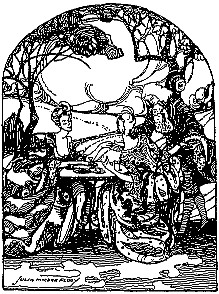
The Watcher by the Threshold by John Buchan, Doran, New York, 1918,
319pp.
A rather Lovecraftian title, which Buchan attributes to Donisarius of
Padua, c.1310 - "Among idle men there be some who tarry in the outer courts,
speeding the days joyfully with dance and song. But the other sort dwell near
the portals of the House, and are ever anxious and ill at ease that they may see
something of the Shadows which come and go. Wherefore night and day they are
found watching by the threshold, in fearfulness and joy, not without tears".
I really must read this, it does have a hero frustrating a human sacrifice in
the highlands of Scotland right in the middle!
Although set up like a novel with eight chapters, this is actually a collection of completely unrelated fantasies varying in length from 17 to 87 pages. The characters share only their nationality - as in most of Buchan, the hero is a Scotsman. One of the heroes here has a Greek mother. The first and longest of the tales, No-Man's Land, is the most Lovecraftian, having to do with the survival of an ancient evil in the highlands. The title story is a psychological ghost story; and others seem to be based on folklore. The last two are short fantasies that might have turned up in Kipling or Dunsany's Jorkens series, about lower-class Scotsmen who become kings of some foreign place. I enjoyed them all, though in most there is the usual difficulty with the dialect.
Extrasensory Ecology: Parapsychology and Anthropology edited by Joseph
K. Long, The Scarecrow Press, Metuchen (NJ) and London, 1977, 427pp, diagrams,
index, references.
This an anthology on curious subjects, published by the same press that did the Lord
Dunsany bibliography mentioned above. Their technique has improved - this 1977 product
is all in typescript whereas the Dunsany book is typeset. These are serious if
inconclusive attempts to link parapsychology with sciences as diverse as archeology and
quantum mechanics. The one on quantum mechanics concludes at one point that PK
(psychokinesis) `does not involve any force' - alas, what then can be the use of it? A
researcher named Forwald was forced to this conclusion when he seemed to find that he
could psychically control the fall of a bouncing die, but could not move a nearly
perfect sphere on a smooth surface - the explanation is that "The nature of
the phenomena lies in the allowed quantum mechanical states of the system and
the associated probabilities for those states."
Murray Moore - may the hair on his toes never grow less - found the last Rye Triscuits in captivity on sale in a Canadian supermarket and sent me 12 boxes! Or maybe they will be available in Canada indefinitely - Nabisco has a Canadian arm called Christie Brown that puts out the same product as we used to get here but explains it in French.
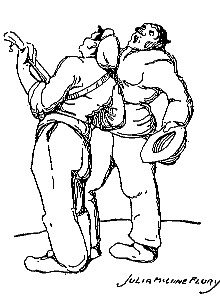
Soapbox Alert - Who was it said that a civilization should be judged by its prisons? Our so-called U.S. civilization now has over a million people in jail, with 180 more joining them per day. The local jails are all hellholes at well over 200% of design occupancy, and the local gendarmes, according to the local press, are torturing suspects again. From all accounts, the rest of the country is no better off. In states with the death penalty the crime rate is no lower than in those without, but 43 of the convicts sentenced to death since 1973 were later found to be innocent - most of them had not yet been executed, thanks to the appeals process that the Newtoids are trying to eliminate. Do you feel safer yet? Just wait until the Newtoids get rid of AFDC (aid to dependent children), public schools, and welfare...
20th Century Bible, J.R.Angels Co., West Hartford, 480pp, wraps,
$38.75.
No, I don't have this book or the $ to waste (address Box 370-383)
but I was intrigued by their ad:
Fast Food Alert - The president of McDonald's Japan, Den Fujita, has stated that `the reason that Japanese people are so short and have yellow skins is because they have eaten nothing but fish and rice for two thousand years. "...[I]f we eat McDonald's hamburgers and potatoes for a thousand years we will become taller, our skin become white and our hair blond." [In These Times 12-26-94, p.13]
Open Secrets V.1#1, August 1994 (Box 722 Washington DC 20044) is the newsletter of the Coalition on Political Assassinations - not at all clear whether they are for or against such procedures... And how did I get on their mailing list? In general I am firmly opposed to such acts (little loss as most politicians would be, it sets a bad example), but as a science-fiction fan, of course I would be curious to visit the parallel universe where, say, Hitler was killed before he came to power.
Script edited by Lewis F. Brown and Fay P. LeCompte, Williams Printing
Co, Richmond, 1930, 323pp.
This anthology of literature produced by students at the College of William and Mary is
an interesting sample of the period. Of the eight short stories, one is pure fantasy
(much in the manner of Lord Dunsany), one is a science-fiction sea story (a new poison
gas), one is a ghost story, and one is occult fantasy. The essays are weak, except for
one that recounts the history of duelling in Virginia. The poems are drivel, to my
taste. There are only two plays, and the second - again a fantasy much in the manner of
Lord Dunsany - is the only piece in the book by a writer that I ever heard of,
G. Peyton Wertenbaker. I am always curious looking into old college anthologies
whether any of the authors became famous later. Such a name is harder to forget
than what he was noted for as a writer! I don't seem to have any books by him
and he isn't in Webster's Biographical Dictionary. And yet I know the
name is familiar...
Canada and the Atomic Revolution by D. M. LeBourdais, McClelland &
Stewart, np, 1959, 199pp, photos, maps.
A detailed account of the discovery of atomic fission and the Canadian uranium mining
industry, with emphasis on the executives involved - most of the photos are of their
totally forgetable faces. Nowhere can I find any mention of what would be done with the
spent fuel of the reactors!
Hearts of Gold by Milt Gross, Abbeville, New York, 1983, 246pp, wraps, $7.95.
This is a facsimile reprint of the 1930 Doubleday Doran book He
Done Her Wrong, a novel done entirely in cartoons - `not a word in it - no
music too' as the author notes on the title page. Of course, the title page has
words, but the rest of the book lacks even cartoon dialog, though there are the
words such as in signs on the city walls. The plot reminds me of one from the
Dudley DoRight TV cartoons.
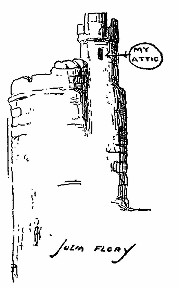
Spectre-Room of Fantasy by Ayresome Johns, Apocrypha Press, np, 1989,
48 unnumbered pp, illus by divers hands, wraps, #49/50.
A most peculiar and amusing production sold to me by George Locke of Ferret Fantasy in
England. The first half seems to be a parody of Locke's own A Spectrum of Fantasy
(of which the second volume is now in print), the difference being that none of the
books listed ever existed in that format - one is an edition of Bram Stoker's
Dracula listing Hall Caine as first co-author with Stoker. There is also
a running joke about an obscure sort of aircraft called a sambar.
The second half of the booklet is a fragment of a story called The Invisibles, set up in 8-pt double-column like a 19th-century gothic novel. It is about an Elixir of Life discovered by the renegade Rosicrucian Hoathley Morland in 1641 - and, I suspect, a modern invention like the rest of the book.
The ORIGINAL Feminist Attack on the Bible by Elizabeth Cady Stanton,
Arno Press, New York, 1974, xlii/152/217pp.
Arno has produced a number of odd books over the years, including a reprint of the A.
Merritt/Hannes Bok The Fox Woman and The Black Wheel. On the title page of
this book the imprint is said to be a `New York Times Company'.
This is a facsimile
reprint from the 1895 and 1898 editions of The Woman's Bible (European
Publishing Company), originally in two volumes, and apparently from the author's
own copy. The format consists of reprints (selected as having to do with women
or gender) from the King James translation in standard doublecolumn 6-pt,
followed by commentary in conventional text. The commentary was done by a large
committee of women under Ms Stanton, most notably (according to the
introduction) a radical theosophist named Clara Bewick Colby, and each entry
bears the initials of the author.
The commentary is quite clearly written and lively, with many examples, such as the fact that (at the time of original publication, in England) a man might marry his brother's widow but was forbidden to marry his deceased wife's sister.
Introducing Kafka by David Zane Mairowitz, Kitchen Sink Press (320
Riverside Dr), Northampton (MA 01060), 1994, 176pp, illustrated by Robert Crumb,
wraps, $11.95.
I got this mainly because I am a Crumb fan, and certainly any Crumb fan would want it, as
his art takes up as least as much space as the text. If you want to know something about
Franz Kafka and why he wrote such bizarre stories, this is probably the easiest way to
learn it. Hard to imagine what Kafka might have thought of it!
The Zon Manuscript was written by Dr. Frank R. Wallace, a Senior Research Chemist with DuPont who left to pursue research in the Unified Field Theory. Instead, he discovered Zon, which has to do with "Predicting and Controlling Future Events With Absolute Certainty For Big-Bang Explosions of Wealth, Power, and Romantic Love". And Dr Wallace was willing to share this marvel with anyone (except `value destroyers': all politicians and business quislings, most lawyers and reporters, and many bureaucrats, clergymen, and university professors) who had a loose $70 to spend. Alas, he sent the promotion to my mother rather than to me, and by the time I saw it, the January 27 1995 deadline had expired. Now I would have to pay $500 for it. Alas, I can't do that and publish this fanzine too, so Dr. Wallace is out of luck. But if any of you has a loose $500, tha address is Neo-Tech Publishing, 850 South Boulder Highway, Henderson NV 89015.
Voices From Shadow, ed. by David Sutton, Shadow Publishing (194
Station Rd, Kings Heath, Birmingham B14 7TE, England), 1994, 64pp, wraps,
illustrated, $9.
Alan Hunter, who is doing the art for my long-delayed booklet about the song Green
Hills of Earth, sent me this anthology of commentary from the early-70s British horror
fanzine Shadow. In addition to his art (which was based on C L Moore's Jirel
stories, though I didn't know that when I asked him to illustrate her Quest of the
Starstone for my booklet), there are excellent pieces by Stephen Jones, Jim Pitts,
Brian Frost, and Dave Carson. Includes a long article on psychic detectives by Mike
Ashley, Ramsey Campbell on Lovecraft, and articles on C L Moore, Robert Aickman,
and William Morris.
The X-Phile is a fanzine for fans of the TV program The X Files, which doesn't quite include me - I've watched it a few times and they have some interesting plots (usually skimmed from sf of the 50s), but the two FBI agents who reappear in each episode seem to me to lack any depth or acting ability. This is V.1#2 that appeared in my mail, so they haven't been at it long. 40 well printed pages, with one piece of fanfic, a crossword puzzle, and photo art. The editors seem to be a junta lead by Johnny Olson, and the address is Box 3138, Nashua NH 03061 - $20/year, which seems to be 6 issues.
Make a Plan, Man by C F Kennedy, Necessary Press (Box Forty, 90 Shuter
St), Toronto, 1994, 11pp, wraps.
Politico-economic commentary in rather large print, printed recto only. Kennedy
recommends that all forms of welfare be abolished and replaced with a guaranteed minimum
income. This would certainly reduce the cost of the administrative bureaucracy, but the
level of this income would have to be set so that enough people still wanted to be
employed - what use would a guaranteed income be in a society where the sewers
don't work?
An Anthropomorphic Bibliography, compiled by Fred Patten, Yarf! (Box
1299), Cupertino (CA 95015), 1995, 38pp, illus, wraps, $5.
Yarf! is the `Journal of Applied Anthropomorphics', edited by long-time fan Fred
Patten, a fanzine devoted to stories in which animals act like people (or people have
more fur than most of us). Beautifully printed with excellent art, though I
don't think Mark Merlino was quite up to the task of depicting a erminoid alien
doing the Dance of the Seven veils upside down in a tree - perhaps no one is. I
was a little surprised not to see even one piece by Taral, who has been doing
wonderful anthropomorphics for years.
As a bibliography this has a ways to go - he lists Piper's Little Fuzzy stories and Cordwainer Smith's Instrumentality series, but misses Simak's City with its intelligent dogs, Don Marquis' Archie & Mehitabel, and Franz Kafka's cockroach too.
Anatomy of Wonder (4th ed., revised) ed. by Neil Barron, Bowker, New
Providence NJ, 1995, 1000pp, $52.
I have only the blurb on this - the turkeys might have sent a review copy! They note that
7 years have passed since the last revision of this guide to all things `sci-fi'.
The Singer in the Stone by John Willett, Houghton Mifflin, Boston,
1981, 86pp.
Willett dedicates this to his mother, who "led him to the banks of the great
grey-green greasy Limpopo River, all set about with fever trees"', a quote that
should be familiar to any fan who ever heard the song Bouncing Potatoes - this
quote is from Kipling's `Just So' story about the Elephant's Trunk. The book is a rather
good philosophical fantasy, probably aimed at the young adult market.
The Secret of the Sangraal by Arthur Machen, Tartarus Press (5 Birch
Terrace, Hangingbirch Lane, Horam, Sussex, UK), 1995, 286pp.
I don't remember the price, which is probably just as well as this is #56/250...
Beautifully printed on an ivory stock and bound in gold-stamped black cloth. The
38 pieces are mostly non-fiction (as much as such a distinction can be made in
Machen's work), and there is some overlap with my own Guinevere and
Lancelot. Most notable here as important Machen works that are hard to find
are the title essay and the one about the mysterious poem Tom O'Bedlam,
which includes the complete poem. The last 25 pages are Machen's fascinating
comments on his own books.
Steve Sneyd incloses a flyer from Galactic Central (Gordon Benson Jr, Box 40494, Albuquerque NM 87196 or Phil Stephensen-Payne 25A Copgrove Rd, Leeds, W. Yorks. LS8 2SP, UK) for current bibliographies on a long list of sf authors. These are priced at $1.50-8.00 (1-5 sterling). Somehow they missed Tanith Lee, I would have ordered that myself. Steve also incloses a page about the `Dragonby Bibliographies' (Richard Williams, 15 High Street, Dragonby, Scunthorpe, S. Humberside, DN15 0BE, UK) - these are mostly by publisher, but under the heading British Author Checklists (at 50p each) we find only Fredric Brown and Bruno Fischer! The Brown checklist includes the films.
Alice in Wonderland adapted for the stage by Eva Le Gallienne and
Florida Friebus, Samuel French Inc., New York, 1976, 154pp, diagrams, wraps.
A reprint of the 1932 original. The diagrams are technical staging
instructions. The casts of the 1932 production and a revival are given - besides
the two authors, they include Burgess Meredith as the Duck, the Dormouse and
Tweedledee, Whit (his given name is Whitner) Bissell as the Seven of Spades,
William Windom and Julie Harris as the White Rabbit, and Eli Wallach as the Duck
and the Two of Spades.
Federal Employees News Digest for February 27, 1995 notes that the Supreme Court has, as expected, found unconstitutional the provision of the 1989 `honoraria ban' that would have prohibited me, for example, for being paid for a poem or an article on fanzines or antique typewriters. Technically, this case is known as "U.S., et al v. NTEU, et al, No. 93-1170, February 22, 1995". Free at last, praise the Lord, free at last...
Topper Takes a Trip and Turnabout by Thorne Smith, Methuen,
London, 1951 & '57, 384 & 360pp.
Someone sent these from Australia
without note or return address. They are marked $5 each on the front fly, which
would have been a fair price with the d/w, but is a bit high without. Of course
they are scarcer there than here. It would probably be better to write before
sending British reprints of US authors!
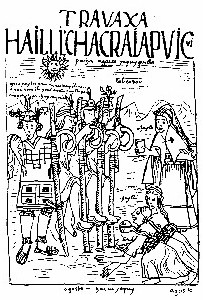
Image of the New World by Gordon Brotherston, Thames and Hudson,
London, 1979, 324pp, illus. line, photos and maps, index, $19.95.
This is subtitled the American continent portrayed in native texts and is very
detailed and technical. I had no idea that there were that many different native
languages that had translatable texts! Guaman Poma's Nueva Coronica from
1613 looks like a collection of fanzine covers...
Night World by F. Paul Wilson, Jove, New York, 1993, 389pp, wraps,
$5.99.
Truly horrific... I had seen the movie The Keep based on the first novel in a set
of six (so far) that he calls The Adversary Cycle, but until I read this I didn't
realize it was a series. If he's trying for another sale to Hollywood I'm afraid he's
tried too hard, I don't think the special effects people could keep up with his disasters!
The metaphysical viewpoint of this book is unusual, I can only describe it as agnostic occult pessimism - we have supernatural effects and reincarnation, but there seems to be no deity and the super-villain is not `evil' but merely catastrophic in that he feeds off of the negative psychic energy that he induces in the general populace.
From Cave Painting to Comic Strip by Lancelot Hogben, Chanticleer, New
York, 1949, 287pp, illus color & b&w, index.
Hogben was, in a way, the Isaac Asimov of his time. This book on graphics has over 200
illustrations, very well chosen and printed. There is an agate ring of the 11th century
with a runic inscription (outside, rather than inside like Frodo's), 17th century
shorthand, a 9th century Arabic proof of the Pythagorean Theorem... None of the
comic strips shown have anything like the art of the two paintings from the
caves of Altamira!
The UK to USA Dictionary, Hunter & Dervaes, Solitaire (Box 14508),
Tampa (FL 33690), 80pp, wraps, $7.95.
And vice versa. Many of the terms quoted would probably be understood in either
country, but others might be useful to people going to the Glasgow worldcon. `Clockwise'
in Scots dialect, for example, is `deasil'; and `wee doch and dorris' is said to be Scots
for a last drink, `one for the road'. On the other hand, their advice to UK residents
looking for an indoor pool that they ask in the US for the way to the
`natatorium' seems a bit off the edge!
Mr. Munchausen by John Kendrick Bangs and Roots of the Silver
Tree ed. by Mark Owings
These are IBM/DOS ascii disks issued by Mark Owings, the second one being a 2-disk
anthology of traditional fantasy. Address 1113 W.40th Street, Baltimore MD 21211. Any
wordprocessor or editor in a DOS computer (or even, I am told, the latest Macs) can
display these files for reading or they can be printed. All of the material is old enough
so as to be in the public domain.
The Compleat Flea by Brendan Lehane, John Murray, London, 1969, 126pp,
illus photos and line, index, d/w, 1.25 sterling.
This copy escaped from the British Joint Services Library on Gibraltar! More about fleas
in art, literature, and nature than anyone could stand to know, including a hideous
William Blake picture called `The Ghost of a Flea', a photo of a tiny cross-bow
(called, oddly enough, a `cannon') supposedly used by Queen Christina to shoot
at fleas, an antique flea trap, a chapter on flea circuses. We also learn that
the largest British flea infests the smallest British mammal, the pygmy shrew;
but that this flea is only half the size of the largest flea, the North
American, which can reach over a quarter inch in length.
Aha, I see how this came from Gibraltar - Chuck Connor, who is stationed there with the British navy, sent it.
A Spectrum of Fantasy Vol.II by George Locke, Ferret Fantasy (27
Beechcroft Road, Upper Tooting), London (SW17 7BX, UK), 1994, 156pp, $99.
This gives detailed descriptions of some 1250 books added to his collection
between 1980 and 1993. Limited to 450 copies, bound to match Vol.I. This is an
essential reference for collectors of obscure fantasy. There is also a large
section on corrections to Vol.I.
The Night Land by William Hope Hodgson as condensed and mapped by Dave
Hall, Purple Mouth Press, Newport News, 1995, 63pp, 6 maps, wraps, $10.
There are only 126 copies of this, of which 50 (at most) will be for sale.
Handbound by ye ed, and I have the bursitis to show for it.
A Few Letters From Arthur Machen (8.95) and The Good Machen
(7.95), Aylesford Press, 1993, photos, wraps.
These reprint pamphlets may still be available (158 Moreton Rd, Upton, Wirral, Cheshire,
England - prices are in pounds). The letters were written to Munson Havens and originally
published by the Rowfant Club in Cleveland; while the second book is a reprint
of the material from the 1963 Centenary of Machen's birth.
A Hannes Bok Showcase ed. by Stephen D. Korshak, Charles F. Miller
(708 Westover Dr), Lancaster (PA), 1995, xv/88pp, illus b&w and color,
$29.95.
A follow-on to the Hannes Bok Treasury of 1993, published this time by Miller
alone after the dissolution of the long-time Underwood-Miller partnership. Eight of the
full-page plates are in color. There is a $17.95 paperback with all the same art except
for the endpapers that appear only in the hardbound edition. There is a foreword by
Frederik Pohl. Beautiful stuff - and a third volume is promised!
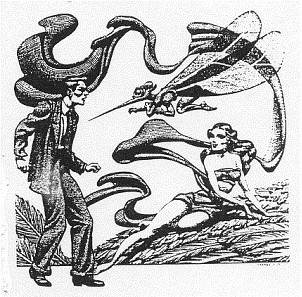
The Blue Book of Crime by T. G. Cooke, Institute of Applied Science,
Chicago, 1945, 80pp, illus diagrams, photos and color.
On the spine and at the bottom of the cover is says Science of Crime Detection. On
an insert, Cooke claims that `half the bureaus of identification in the United States'
employ graduates of his Institute. The material is quite interesting, but seems
to be aimed at the lowest common denominator - under a photo of a `typical
American Bureau of Identification' it says "Don't you think it would be a
nice place in which to work? An Identification Expert must necessarily have a
clean office with plenty of light and fresh air". Included are photos of the
Identification Bureaus of Mexico City, Berne Switzerland, and Nairobi Kenya...
More interesting is a page devoted to the arrest photos and fingerprints of John
Dillinger - anyone could tell he was a crook from the smirk on his face!
Anti-Ice by Stephen Baxter, Harper/Prism, New York, 1993, 289pp,
wraps, $5.50.
Pretty good alternate-history sf - probably held my interest because of the
socio-political commentary. The hero is a twit. The gimmick that
drives the history of Earth in a different direction is the arrival of a sort of
anti-matter satellite of which fragments are found in the polar ice and used as
an energy source without any real understanding of their nature, as the action
takes place before the advent of modern physics, around 1850-1910 in our
time-line - the first use of anti-ice as a weapon is as a crude bomb at the
siege of Sebastopol, thus ending the Crimean War. By 1910 the British Empire has
anti-ice missiles aimed at every capital in Europe, thus imposing a Pax
Britannica similar to the Cold War of our world.
It would be interesting to know who the publisher employs to make up the blurbs - besides praise from Locus, Moorcock, Charles Sheffield, and Joe Haldeman we find a quote `He writes like I used to... I should have him assassinated before it's too late!' attributed to David Niven. David Niven? Perhaps the confusion was generated by a back-cover blurb comparing Baxter to Jules Verne - David Niven did play the hero of the film version of Around the World in 80 Days.
Ray Zorn is selling me his Eric Linklater collection. It includes some duplicates, and I already had some Linklater books, so if you are interested in Linklater you might drop me a line.
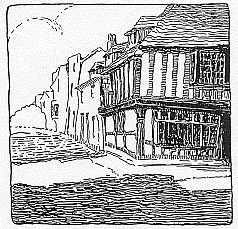
The Weird Tales Story by Robert Weinberg, Fax Collector's Editions,
West Linn (OR), 1977, 134pp, d/w, illus., $17.50.
I ran across this at Benders in Phoebus at only slightly over the original price, odd
that I didn't already have one. There are five Bok illos so I have entered it into the
Hannes Bok Illustration Index file. An excellent history, partly by
Weinberg and partly articles by surviving WT writers from the 1973 booklet
WT50, with many photos. Other than art reprinted from Weird Tales,
the book is decorated with work by Alex Nino, Frank Magsino, and Orvy Jundis,
obtained through the Phillipine Science Fantasy Society and the Phillipine Comix
Archives. I see that Weinberg has autographed this copy to a Charles Kraemer.
The R'LYEH Text edited by Robert Turner, SkooB BookS, London, 1995,
175pp, b&w illus., bibliographies, wraps, $11.99.
This is the book promised, I think, in 1993, a sort of sequel to their 1992 edition of
The Necronomicon. It was printed in Malaysia to match the first volume and
includes material by George Hay, Colin Wilson, Patricia Shore, and Arnold
Arnold. Included are parts XIX-XXIX of `The R'yleh Text' written at Damascus by
Abdul Alhazred in 730 AD, as translated by Robert Turner (parts I-XVIII appeared
in the matching volume published in 1992).
Wonderful stuff, reminds me of the Profile By Gaslight (Simon & Schuster, NY'44) that I found on a recent trip to Atlanta, where members of the Baker Street Irregulars contribute chapters based on the assumption that Sherlock Holmes was a real person. The address for SkooB is 17 Sicillian Ave, Southampton Row, London WC1A 2QH, or, as The R'LYEH Text has a standard ISBN (1-871438-90-X) bar code block with the dollar price, you may find it at your local specialty shop.
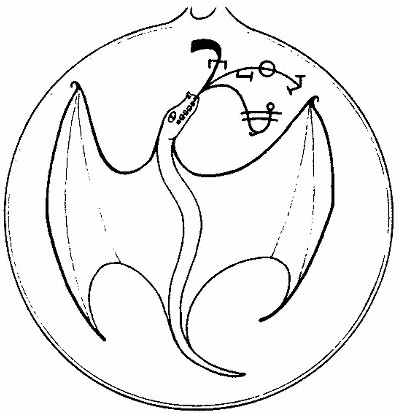
We have discussed here before the Albiginesian heresy and the fall of Carcassonne, at which some Catholic bishop is supposed to have decreed that the inhabitants were to be slaughtered one and all - "Kill them all, God will look after his own!" Alas, this famous quote may be a fabrication. Recently at a flea market I got Massacre at Montsegur by Zoe Oldenbourg, translated from the French by Peter Green, Pantheon, NY'62. On p.116 we find the following explanation: "...The famous, too famous, remark, attributed to Arnald-Almaric by the German, Ceasar von Heisterbach, is not so much a genuine historical mot as a critical comment on the nature of this episode. It might serve at the motto for any ideological or supposedly ideological war. Whether Arnald had sufficient imagination to coin a phrase of this sort, or whether he in fact never said the words at all, it remains true that the Crusaders' instructions at the sacking of Beziers do indeed seem to have been `Kill them all' - with or without the rider concerning itself over how God might treat the souls of their victims."
Arnald-Almaric was Abbot of Citeaux and later Archbishop of Narbonne - but note that the siege was that of Beziers, a much smaller place than Carcassonne. Beziers fell on July 22, 1209, and Carcassonne a few weeks later, on August 15 - but there was no large-scale slaughter at the fall of Carcassonne. Arnald-Almaric lived until 1225, so perhaps he made up the famous quote in retrospect as part of his tales of the war on the heretics. Tom Disch uses the quotation correctly in his new novel The Priest (Knopf, NY'95).
Shatterworld by Lelia Rose Foreman, Eerdmans, Grand Rapids MI, 1995,
162pp, wraps ($5.99) and hardcover ($13.99).
This juvenile (10-14) sf first novel from a publisher who specializes in religious books
came to me as a review copy of the trade pb and a sample of the d/w to the hardcover -
neither notes any price, but the author gave the prices quoted above. The cover art is
extremely realistic and shows the teenage heroine in peaceful communion with two
blue aliens who look like a cross between a giant cockroach and an octopus.
The plot concerns the settlement of a distant planet by a oligarchical religious sect. The heroine is named Rejoice-in-the-Lord's-Salvation Holly (called Rejoice), and all of the characters have similarly awkward names. The astronomy and biology seem well done, but the idea that poisonous gases in the atmosphere could be countered with the `simple filter mask' that Rejoice is shown wearing in the cover illustration is a bit beyond my suspension of disbelief...
However, as sf for the target audience, this is not at all bad. The rigid oligarchy even begins to dissolve in the resolution of the plot. The writing is good, and the only typo I spotted was where someone collected a `speciman'. I was surprised to see the old-fashioned Contents, where each chapter number is related to a page number - what would be the use of this?
Up To Now A history of science fiction fandom in the 1930s by
Jack Speer, Arcturus Press, Brooklyn, 1994, 40pp, wraps, $5.
Arcturus Press is Richard C. Newsome (281 Flatbush Avenue, Brooklyn NY 11217). I saw
mention of this in a Canadian fanzine, I think. A fascinating look at early fandom (Harry
Warner is referred to as a `newcomer'), very informal and anecdotal. The text
preserves one of the proposed spelling reforms, eliminating the silent
`ugh' in words such as thought and through (spelled
`thru'). It was originally distributed through FAPA in 1939 and then reprinted
in Dick Eney's A Sense of FAPA in 1962.
All Giants Wear Yellow Breeches by Vernon Patterson, Wm. R. Scott, New
York, 1935, 376pp, d/w, $2.50.
I picked up this memoir of a boyhood in turn-of-the-century Missouri at a local flea
market - mainly because I don't see books of this vintage in d/w much any more. A
well-written account, but what interested me most was the quotation, in a section devoted
to favorite poems, of a verse from the pirates' song in Stevenson's 1883 Treasure
Island:
"And there they lay, ay, damn my eyes,Now, I read Treasure Island as a child, and don't recall any such verse. And neither the undated edition with the Edmund Dulac color plates nor the 1949 edition with the Mervyn Peake art (to my mind the best illustrations of this story, see back cover) that I have contains this verse - does anyone know if it was in the original 1883 edition? How much else has been changed in the text?
Their lookouts clapped on Paradise,
Their souls bound just the contrawise,
Yo ho ho, and a bottle o' rum!"
The People's Pottage by Garet Garrett, American Opinion, Belmont (MA),
1961, 77pp, wraps, $1.
American Opinion was the publishing house of Robert Welch of Birch Society fame - he
reprinted this from a 1953 edition by Caxton in Caldwell (ID). I picked this up in a
local thrift store because of the previous mention of Garrett in this zine - it includes a
photo of him and a short biography on the back cover. It notes that before his death in
1954 (he was born in 1878) he had retired with his wife to a cave on a river-bank at
Tuckahoe NJ! He must have been quite a character...
Educating the Entire Person by Ron Dultz (Box 370985, Reseda CA
91337), 1994, 127pp, wraps, $10.
How do I keep getting suckered into trying to read California psychobabble, even as a
free review copy? Well, it had a nice cover. Dultz is also a poet it seems - two of his
poetry collections are offered here.
I was interested in the subject because of my sister's problems with her two sons, but I found no enlightenment here - short as the book is, Dultz never uses one word where fifteen will do and he repeats himself a lot, so that the content never gets much beyond `We have to teach our kids all the right stuff'.
The Jekyll Legacy by Robert Bloch and Andre Norton, Tor, New York,
1990, 248pp, $17.95.
Somehow I missed this odd collaboration when it came out, found the 1st edition the other
day in a thrift store. It is a sequel to the classic Dr Jekyll and Mr Hyde by
Robert Louis Stevenson. The typography is superior to what I usually see these days, but
the style, alas, seems to owe more to Norton than to Bloch - though I must admit I have
read a lot more of his work than of hers. Perhaps the pace will pick up a bit further
in...
Unarmed But Dangerous by Hal Crowther, Longstreet, Atlanta, 1995,
330pp, $19.95.
Longstreet is part of the Cox Enterprises conglomerate which includes Cox Newspapers. And
yet the only place I ever saw Crowther's excellent column of commentary was in the local
weekly throwaway paper PortFolio, which I no longer see at all because they stopped
distribution on the Peninsula. I didn't always agree with Crowther, but at least he had
clearly expressed opinions about interesting aspects of our culture - and very short on
bullshit. His style has something of Mark Twain and something of H L Mencken (he won the
Mencken Award in 1992) and a serious concern with the nature of truth. He notes
in the introduction that it is easier these days to talk about transexual
bestiality than the nature of truth.
Green Shadows, White Whale by Ray Bradbury, Bantam, New York, 1993,
267pp, wraps, $5.99.
The mass market pb of the 1992 Knopf edition. I hadn't read much Bradbury lately, and
it's been a long time since I saw the movie Moby Dick, but this account of
Bradbury's stay in Ireland in 1953 as script-writer to John Huston turned up in some
accumulation of sf paperbacks and I stuck it in my jacket pocket to read at odd moments.
I highly recommend it if you are interested in Ireland, or in John Huston - or as pure
story. I would guess that what Bradbury put down as his own experience is mostly true,
and what he records as told to him by his Irish friends in Heeber Finn's pub and
especially by John Huston is mostly fantasy - but it is all a great yarn.
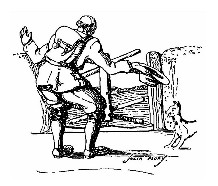
We also heard from (CC denoting a Christmas Card):
The Arthur Machen Society (Rita Tait, 19 Cross Street, Caerleon, Gwent NP6 1AF, UK)
with their excellent Avallaunius 12, which includes a Sidney Sime
illustration done for Machen's The Hill of Dreams but never published;
and two pieces by Machen admirer H P Lovecraft.
David Bates (CC), who tries to straighten out the matter of the Hannes Bok art
misused in the British pulp Space Fact and Fiction of the early 50s. He also notes
that `Garet' Garrett's real name was Edward Peter Garrett and lists a dozen novels by him,
1911-1944; and incloses a bunch of Bok xeroxes; and a copy of his PEAPSzine
New Aura which reprints a curious 1908 end-of-the-world story by Van Wyck
Brooks.
Harry Bell - not! The last two issues have been returned from the Tyne & Wear
address - I have gotten a new address from Jeeves and Lichtman.
Ruth Berman, who notes that Salman Rushdie had a Star Trek story called
Chekov and Zulu in The New Yorker last year. She also explains the origin
of the odd epigraph ("The trees said to the bramble come reign over us") in Garet
Garrett's Harangue mentioned last time - it's from Judges 9 in the Bible
and she says it is a commentary on the uselessness of government.
Sheryl Birkhead (CC) and a Teenage Mutant Ninja Turtle card showing `The Shredder and
Krang' - I'm glad I don't know which is which...
Margaret Boothroyd (CC), who like myself once lived in Chile - Salud y pesetas!
She sends a clipping on hiking in the Andean highlands in Chile, and a poem in Spanish by
Ignacio Verdugo about the Chilean national flower, the copihue.
Chuck Broerman, who is looking for New Worlds from the period when it was
edited by Mike Moorcock; and sends some startling xeroxes from the 1906 Diagnosis of
Nervous Diseases by Purves Stewart - a `hysterical' woman is shown naked from the
waste up with safety pins thrust through her breasts, while a man with a jaw
paralysis has his identity carefully protected by a cardboard mask (but you'd
know that bowtie and mustache anywhere). Chuck writes again later about Robin
Hood, who he says was primarily a pagan demigod and only incidentally a
political folk hero at the time of Richard Lionheart.
Daphne Burleson, who sent a blurb on her novel about Ebrona, the female Glandoid -
it was never clear whether this was something she thought I might publish or
something she thought I might buy copies of. Then she sent the manuscript...
Vinc Clarke, who sends an apazine and the addresses I had asked for of
the people who hold the rights to the Maurice Walsh books - turns out that
Sons of the Swordmaker that Hank Reinhardt was interested in reprinting
is currently in print in England, in both pb and hardcover. The apazine shows
the cover of his rarest book - The Swoop by P.G.Wodehouse. Subtitled `How
Clarence Saved England', it is said to be worth several hundred. The cover shows
a Boy Scout and his pet lion confronting a trio of vultures, two of which are
wearing crowns and the third a fez!
Tom Cockcroft, who sends a copy from the Robbins Encyclopedia of Witchcraft
& Demonology of the entry on the `Hand of Glory'. This account is ambivalent
about whether the fingers were to be lit or the Hand used to hold a candle - if the
candle was separate, it was to be made of `the fat of a hanged man, virgin wax, and
Lapland sesame'. Tom also sent a color xerox of the US and British covers of the From
Unknown Worlds that I mentioned last time, and I have framed it. And he sent some
fascinating pages from a biography of Norman Lindsay, mostly about the picture
The Crucified Venus.
Chuck Connor, with about 1000 typeset words - he liked the Brad Foster cover and says
he may be able to get the Titus Groan tape that Rick Norwood wants. Chuck also
recommends Hodgson's House on the Borderland as superior to The Night Land,
and also for having lots of mystical piggy references. In a later letter he promises a
dub of the BBC radio production of Gormenghast. He did send these tapes and I
enjoyed them very much in the car on the drive to Atlanta in May.
Chester Cuthbert, who says he enjoyed Daniel Pinkwater's Worms of Kukumlima
and also incloses his notes on three of the wonderful books of Laurie Lee,
Cider With Rosie, A Rose In Winter, and As I Walked Out One Midsummer
Morning.
Bill Danner, with a copy of SteFantasy 115 "up to 81.67% milder and
published continuously since 1945", all handset 8-pt letterpress, with an ATom
cover.
Hank Davis (CC)
Brad Day, who notes that he is 78 - besides his reference books mentioned last
time, he has also written three sf novels and published them in small editions - A
Rare Company, The Mineral Kings and Monster Green. Prices are not set
either - write him at 206 Water Street, Hillsville VA 24343.
Gary Deindorfer, who says he has suspended publication of his Spud and
says he agrees with me that Robert Jordan's Wheel of Time books owe
perhaps a bit too much to Tolkien.
Mike Dobson, who sank from fandom, through gaming, to doing management seminars -
even the least of us can serve as a bad example...
Alex Eisenstein (see bacover about Emsh project), who kindly sent a permission to
copy the Bok cover on Trumpet 9, a 1960s fanzine that he was co-editor of, with
the late Tom Reamy.
Al Fitzpatrick (CC), who sends 8 pages of ghastly handrot with a disgustingly
long list of the books he has read (200 in 1993 and 150 in 1994) - well of
course if you don't publish you have more time...
George Flynn, who says that the `news item' about a federal law to prohibit use of
the information highway while drunk or to discuss sex was a hoax originating in PC
Computing.
Don Franson, who sends the lost address of Don Martin, who
collaborated with me in the 1960s on the Hannes Bok index I just reprinted; and
asks am I serious about wanting corrections to the Bok index - yes, it is a
computer file and easy to correct!
Diane Fox (CC), who also sends a copy of the mystical Adventures of Christian
Rosy Cross by David Foster - but I mentioned that several issues back. Anyone want
the extra?
John & Serena Fusek (CC)
Steve George, who says he liked the review of Alembic and that Charles
Williams is the author that got him started in modern horror.
Jim Goldfrank (CC), who wrote late in February that he is recovering from complex
hip-joint surgery.
John Haines, who hopes that the map was a spoof (sorry, John) and incloses his
own zine Handshake along with a coupon good for `5 Busy Lizzies' at the
Trebaron Garden Center in Newton-LeWillows.
Dave Hall, whose condensation of Hodgson's The Night Land I have published
this year. He sends a photo of a Yosemite historical marker that says "On this
site...Theodore Roosevelt sat...with John Muir and talked forest good..." -
I wonder if Roosevelt talked English that bad!
David Heath (aka Deathsayer), who has fancy neepneepery - his letterhead includes
his photo in color - asked about the Hannes Bok Illustration Index. I sent it to him
as a floppy. In the mean time, someone told me on the phone that the dittoed
preliminary version of this from the 1960s turned up in a dealer's list at $45 -
makes me feel ancient!
Arthur Hlavaty et al (CC), whose domage seems to include a dog, a cat, a
rabbit, a gerbil, a coyote, and a wombat... Very fannish to have a wombat - Alan Frisbee
was bitten by a wombat after the 1975 Aussie worldcon and was never the same again.
Neither was the wombat...
The House of Humour and Satire in Bulgaria (POBox 104, 5300 Gabrovo),
with notices of their Twelfth International Biennial of Humour and Satire in the
Arts to be held May 20 - September 30 of 1995. Prizes are offered for entries in
the fields of Fine Arts (cartoons, painting, sculpure), Photography, and
Literature.
John Howard, who sent a postcard showing the White Hart
Hotel in Lincoln (UK) where he spent his honeymoon - best wishes!
Kim Huett (CC - homade, quoting the first verse of Jabberwocky!)
Binker Hughes (CC - of Santa playing golf with his elves), who also
sends a calendar!
Ben Indick, who informed me of the existence of the Lord Dunsany bibliography; and
says that he took Jack Grubel to Hannes Bok's apartment c.1949-51 to have that Bok
bookplate made that I found in Birmingham!
Terry Jeeves, who liked the Brad Foster cover.
Herman Stowell King (CC), who came by to see me late last year from his
hermitage in Wicomico.
Mad-Dog Madden, who says he gave his Rex M-4 mimeos to his church to ship to a
church in Ekaterinburg Russia - I remember when fans got their mimeos from a
church... I hope the Russians realize that M-4 ink won't flow very well below about
60oF!
Don Martin, who collaborated with me on the Hannes Bok illustration index about
25 years ago - he has since sold and rebuilt his collection.
Michael McKenny, who says that the first novel of M. A. Bramstrup (Star
Destroyer, etc.) is Saga of the Star Stallion (Carlton, NY'73).
Murray Moore, who writes on the back of his wife's campaign poster for
`English Language Public School Trustee' (probably because it includes his
picture - looks like a banker) and says that the Brad Foster art detracts from
the yellowosity of the paper used for #13. Each to his own taste (said
the farmer, as he kissed the wrong end of the cow...).
Carlos Rubido Morales (Apartado 99, ZP 10100, Ciudad de la Habana, Cuba), who
sends a flyer on the Ibeficcion/94, an sf convention scheduled for December 12-16 in
Havana. This flyer arrived in early December, all in Spanish and seems very
sercon, even pompous, but the reptiloid alien on the front is suitably silly.
Dale Nelson, who sends another excellent short story and even went to
the trouble of looking up the wonderfully strange A Drink With a Witch by
Laurie Lee. He also sent copies of his apazine for The Everlasting Club,
the ghost story apa, which includes an interview with Russell Kirk.
Arnie Norris (CC), who doesn't seem to be on the mailing list.
Sue & Harry Orr (CC), who make wine down in Tennessee. The stamp is cancelled
with an octopus like many I have seen lately - or has Cthulhu taken over the Post
Awful?
Mark Owings, who in addition to the computer disks mentioned
above, says that Steve Patt had turned into a rock musician by 1973; and that
the `kipple' joke first appeared in a Donald Duck comic - before the Donald
McGill comic postcard, which sold a record 6 million copies? The Electric
Bibliographer must be getting old, he had to ask me the title of the Morgan
Robertson sf tale about the intense cold generated inside a hollow cone of light
ray.
Lloyd Penney, who supplies the text missing from my copy of M A
Bramstrup's Star Destroyer. He says she is now a doctor in New Brunswick
and also writes a comic book. He notes that the `M' stands for Mary and that she
used to sell stuffed toys at Ottawa sf cons. Lloyd also incloses a religious
tract that the Jews for Jesus distributed at Conadian - it is based on Star
Trek and titled `Do You Speak Klingon?'.
Tony Pizzini (CC), who also sent the address to order Mark Sceurman's Weird
NJ.
Mark Rich, who sent his Kornblume 1, a zine dedicated to research on Cyril
Kornbluth.
Rudi Rubberoid, who has folded his long-running graphics zine Nomo and says
he entered fandom just as I did, through one of those ads of the '60s offering a stack of
fanzines for $2 - what was the name of that Johnny Appleseed of fandom who sowed those
zines for so long from an address in New Jersey? I gave him a ride back there once from
a New York convention, but his name has slipped from my aging brainpan. Seth Johnson,
that was it!
Jessica Amanda Salmonson, who say she was glad to know how to find
geas in the dictionary (try geis) and that her guide to growing
miniature vegetables is just out. I was intrigued by her return-address sticker
as Pag-hat the Rat-girl and heard from her later that she does have a pet
rat!
Leland Sapiro, another who spotted the error in my math; and
says that his candidate for worst sf novel is Edmond Hamilton's Monsters of
Mars.
A. Langley Searles (48 Highland Circle, Bronxville NY 10708) with a copy of his
Fantasy Commentator that must contain more words than I have published altogether.
He likes the Flory artwork, says it reminds him of the art Mervyn Peake did for Thou
Shalt Not Suffer A Witch. Langley would also like to know the date of death of fan
Winston F. Dawson; and notes that Bob `Doc' Lowndes (I remember him from the Philcons of
the 60s) would like to get mail (c/o Ruth C. Lowndes, 142 Honeyman Ave,
Middletown RI 02540).
Robert Whitaker Sirignano, who complains that I didn't quote from the ludicrous
Star Destroyer by Bramstrup - well, some books are quotable and others aren't.
David Smith, who has sent a zine called The Printer's Apprentice to all of
the people who were on the mailing list for the The Printer's Devil by the late
lamented Joe Singer.
Leigh Ann Smith, who logged onto some Internet movie database and dumped a page
for me on Ken Russell's 1988 movie version of Bram Stoker's The Lair of the White
Worm - I will never forget the duel between the fat were-snake Scots constable and
the kilted hero armed with a bagpipe...
Steve Sneyd, who sends a mini-postcard (6x2) with a vaguely obscene ad
for the Leeds Book Fair at the Pudsey Civic Hall and says `Cleveland' means Land
of Cliffs - but these cliffs were along the NW coast of Britain. Our Cleveland
is named after a land agent, Moses Cleveland.
Dale Speirs, who sends with his Opuntia 21.1 a flyer on the National
Library of Canada science-fiction exhibit scheduled for this summer in Ottawa.
Mae Strelkov, who says she typed three pages of comments on #13 but then lost
them - sounds a little like the dog ate my homework to me...
Jake Tustin, who sends what he says is his `last $1' for an IGOTS in an envelope
that seems to have been stepped on by a cougar with two left feet.
Mark Valentine, who will have a book on Arthur Machen out in October.
Toni Weisskopf (CC), who pulled some strings in the NY book world and got me
permission to use Heinlein's verses in my booklet on The Green Hills of
Earth (to be published this year, I hope). Toni also sends a list (longer
than I would have guessed) of the sf, fantasy, and horror books first published
in 1895 - of the 37 books listed, I have about half.
Dr. Henry Welch, who opines that he will never read any of the books I review -
see remark to Murray Moore, above.
Mike Whalen, who asks if the books mentioned are for sale - not in general, unless
I published them myself or say I have a duplicate.
George Wells, who sends some Ken Kelly fantasy art trading cards.
Gene Wolfe, who sent me a birthday card a month early, and
quotes a third-hand rumor that someone still gets a Xmas card from Donn
Brazier.
Fred Woodworth, who has sent a great deal of useful info and a manual on the
VariTyper, an old typesetting typewriter; and two issues of his beautifully printed
little Multigraph Newsletter about this machine and the Friden JustoWriter.
John Wright, who writes from South Africa that he has been under treatment for
glaucoma - he once sent me a lot of material on William M. Timlin, author of The Ship
That Sailed To Mars. I had hoped that the recent reprint of this would be enough of a
success that the same publisher would do the long unpublished The Fairy City.
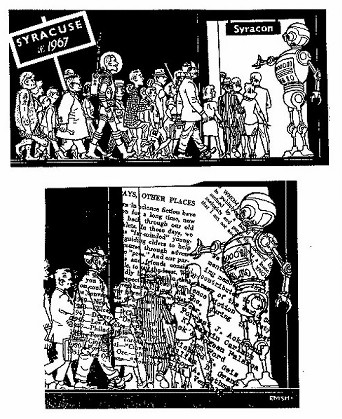
Ed Emsh (who signed his art `Emsh' - his name was Emshwiller) was one of the artists who created the feel of the science fiction of the 50s and 60s, both as a fan and a pro - to the extent that it becomes hard to say how good he was, any more than we can say whether Shakespeare was a `good' writer. Alex Eisenstein has written to say that he is doing a book on Emsh, and is soliciting help in the location of both original and published artwork. Two pieces I found for him are on the back page. He has the full permission and cooperation of the estate. His address is 6208 N. Campbell, Chicago IL 60659, Tel.(312) 274-7064.